-
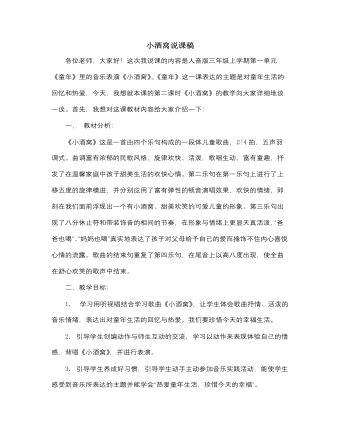
人音版小学音乐三年级上册小酒窝说课稿
鼓励学生创编恰当动作边唱边舞。创设一个情境,让学生们在欢快、喜悦的情境中体会歌曲所要表达的主题。这样不仅能使学生积极展开想象,引发创作灵感,而且有效的培养学生的审美能力。另一方面,我还重视音乐文化方面去开拓,激发学生对音乐的热爱。(二)、课堂小节小小酒窝是甜蜜的,也是幸福的。在我们每个同学身边,有亲爱的爸爸、妈妈、爷爷、奶奶......有亲爱的老师同学,有这么多关心爱护你们的人,你们的成长进步是他们的骄傲。你们是多么幸福啊,老师真为你们高兴。在这里请对他们真诚的说一声“谢谢你们”!【本课教学内容的主题为“热爱童年生活,珍惜今天的幸福!”这个环节,就是促使学生关注自己身边的事物,学会去珍爱自己的生活!从而深化音乐作品所表达的内涵。】当然,以上所述只是我对本课的设想,但不管怎样,我认为一堂音乐课只要能成为学生享受音乐美的圣殿,就是我们教师应该追求的境界。
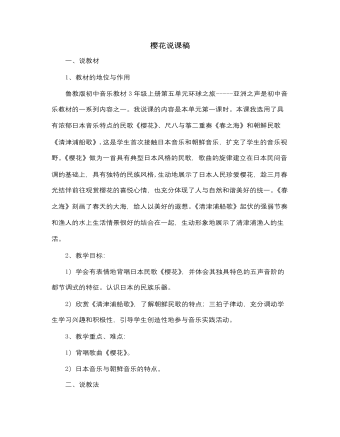
人音版小学音乐三年级上册樱花说课稿
然后出示视频资料,让学生们感到我们又来到了朝鲜半岛的朝鲜。2、欣赏《清津浦船歌》1) 初听:学生感受具有三拍子倾向的6/8音乐的《清津浦船歌》,说出音乐内容。2)《清津浦船歌》是表现朝鲜半岛清津浦渔人劳动生活的歌曲。衬词表现出集体劳动中人们的乐观精神。起伏强弱的节奏和渔人的水上生活情景很好地结合在一起,生动形象地展示了清津浦渔民的生活。3)复听:找出歌曲中模仿鼓声的象声词,跟着音乐敲击节奏一起感受清津浦人的乐观精神。(不经意的举动,其实是对学生创造力的培养。)(四)音乐活动:比比谁的耳朵灵老师分别放了中国、日本、朝鲜的音乐片段,学生回答分别是哪国音乐?(这既能拓宽学生的音乐视野又是对本课内容的当堂检测,回扣了教学目标)(五)课堂小结:今天我们参与了第一次亚洲之旅,学习了东亚日本、朝鲜的民歌。让我们相约,下次一起走进印度、泰国和印尼!
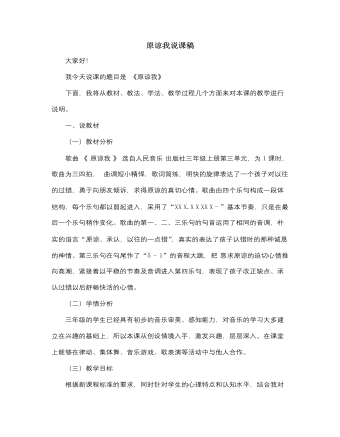
人音版小学音乐三年级上册原谅我说课稿
4)进行分组练唱、对唱、全体学生合唱。在分组练唱过程中,我将在学生中间进行单独指导,询问他们学习的难点并与学生一起解决,然后适当提问个别学生。通过小组唱、对唱等形式进行演唱评比,提高学生演唱热情。这样,不仅加深了学生对歌曲的熟悉程度,还为学生更好地理解歌曲做了铺垫。5)表演唱,通过表演,不仅展示了学生个性、激发学生的创造力、表现力,而且再次加深了学生对歌曲情感的理解和体验。(三)第三环节——拓展延伸通过对歌曲节拍节奏的改编,让学生感受到得到好朋友原谅后又能快乐的游戏的情绪变化,感受到与好朋友在一起是一件幸福快乐的事。本方案的设计,力求体现以人为本的思想,着眼于学生的主动发展,通过充分的音乐实践,培养学生的能力,提高音乐素养;培养学生的合作意识、探究精神。从目标的提出、到过程的安排、学习方法的确定、乃至学习成果的呈现,都让学生有更大的自主性、更多的实践性。
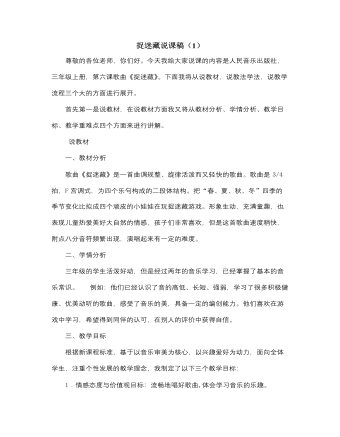
人音版小学音乐三年级上册捉迷藏说课稿(1)
第五个环节,完整教唱。在教唱过程中,首先采用师一句生一句的方式来学唱,接着利用黑板上歌词卡片的两种颜色,来进行师生接龙唱,例如第一遍,我唱蓝色的乐句,学生唱绿色的乐句,第二遍,则反过来。接龙唱以后则全部由学生自己,完整地演唱一遍。最后,我会让他们带着三拍子的强弱规律,再有感情地演唱歌曲。以上五个环节是我歌曲教学的部分。四、拓展部分(7分钟)这一部分我主要让孩子们分组对歌曲的后半部分进行歌词创编。例如,春天除了藏在花丛中,还可以藏在哪里?而四个小组刚好是春夏秋冬组,每个组探讨出一个词来进行创编。最后将新歌词改进去课件中,让孩子们自己来演唱自己创编的新歌曲。五、欣赏部分(5分钟)音乐中描写春夏秋冬四个季节的歌曲有很多,在音乐欣赏的部分,我会让孩子们通过点击课件中的四季娃娃,欣赏其代表的不同的四季音乐,最后进行简单的小结。
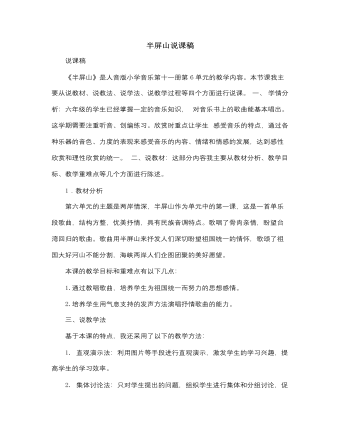
人音版小学音乐六年级上册半屏山说课稿
B:休止符的地方,要提示学生此处不是换气的地方,要注意休止时声断而气息不可断。采用领唱与齐唱的演唱形式,有感情、完整的演唱歌曲。(4)教师完整地范唱歌曲,请学生找出刚才为歌曲伴奏的两种节奏,然后再引导学生发现旋律中还有一种节奏用得较多的切分节奏。准确的打出这三个节奏。(5)以上面三种节奏为主,编创4小节的节奏谱,尝试为歌曲伴奏。五、拓展延伸1.初听乐曲《丢丢铜仔》,听听这首乐曲的旋律与哪一首歌相似?2.简单介绍台湾民歌《丢丢铜仔》的背景及意思。《丢丢铜仔》是流行在台湾和福建闽南一带的民歌,两百多年前,顺水路运送木材的工作在返回宜兰的路上常常唱着这首歌走过山洞。丢丢铜仔的意思是模仿山洞里的滴水声。3.再听乐曲,听出乐曲是由什么乐器主奏的?听后请学生说一说对音乐的整体感受,可引导学生从主奏乐器二胡所表现的形象谈起。
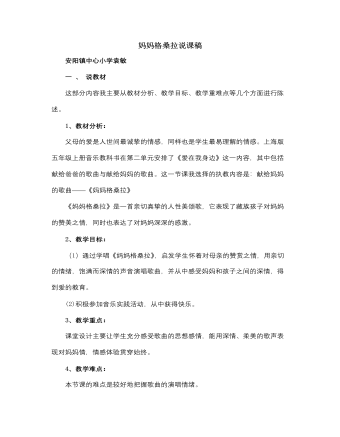
人音版小学音乐六年级上册妈妈格桑拉说课稿
4、跟琴演唱2-3遍,教师弹奏歌曲学生跟琴演唱。要求:(1)速度不宜过快,学生用中速跟琴演唱(2)声音自然统一气息通畅,避免让学生用喊叫的声音演唱,注意保护嗓音。(三)表现歌曲1、学生齐唱,用歌声唱出对妈妈的爱。2、师生合作,用舞蹈跳出与妈妈的情。3、小组讨论交流:给妈妈送上真诚的祝福。(四)课堂小结五、说预设与反思音乐是一种情感教育。学生通过对音乐作品情绪、思想的感受和理解,使其情感世界受到感染和熏陶,在潜移默化中建立起对美好事物的挚爱之情,使学生在真善美的音乐艺术世界里受到高尚的情操的熏陶。通过本堂课学习,主旨在于让学生关心父母,知道父母抚育自己长大很不容易。任何一节看似准备充分的课,难免顾此失彼、多有失误,本节课也不例外。鉴于学习内容多、信息量大的特点,使得这节课突出的问题是时间的分配问题和歌曲的情感理解问题,有待进一步在演唱中体会。
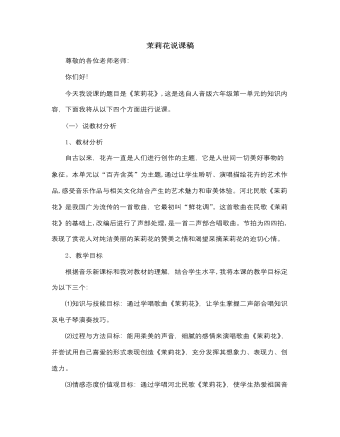
人音版小学音乐六年级上册茉莉花说课稿
音乐新课标提供自主合作探究的学习方式,为了让学生进一步感受歌曲的美,我会提问:歌曲为我们展现了芳香四溢的茉莉花,当你面对这样美的花朵时,你还会用什么方式来表现歌曲?学生分组讨论,诱发学生展现自我,培养他们的合作意识、创新意识和创新精神。这时学生以小组为单位,有的用边画边唱的形式,有的用优美的舞蹈表现歌曲,最后全班同学用电子琴边弹边唱《茉莉花》,将课堂气氛推向高潮。在音乐声中,我的本堂音乐课也就轻松的完成了。(四)说教学评价反思本节课的教学,我始终围绕歌曲《茉莉花》为主线,在学生已有的知识水准上,通过听、说、唱、奏、演等艺术表现手法让学生在音乐活动的过程中感受美、表现美、创造美。学生在活动中积极主动。以多媒体课件作为辅助手段,让学生在视觉与共同感观中感受艺术的魅力。
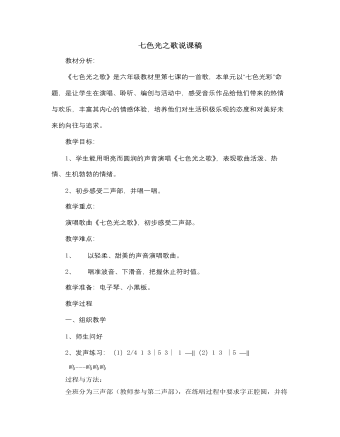
人音版小学音乐六年级上册七色光之歌说课稿
本课我的设计初衷是希望同学们能通过节奏训练,视唱训练将歌曲一步步潜移默化的吸收和掌握。但从学生的表现来看,并不受用。主要原因我反思了下,第一,没有考虑到学生的实际情况,在学生的概念里对音乐课就是玩一玩唱一唱就可以了,讲过的知识也只是听一听而已,并不会刻意的去记一记。学生们的底子也比较薄弱,所以在课堂上所提到的知识点,学生基本上已经忘得差不多了,使练习环节没有达到预期的效果。第二,在课堂上我太过注重将本课设计内容全部完成,却忽视了学生学习情况。第三,在教学中,很多地方太过于专业,使学生上课觉得与知识产生的距离感,导致学生对本课的兴趣减弱。对于以上那个问题,在今后的教学中我会特别注意,音乐基础知识会用一些简单易懂的方法在每节课一点点渗透,让他们在无形之中掌握。课堂上会多关注学生学习情况,掌握情况。切实从学生们的实际出发,让他们真正爱上音乐课,受益于音乐课。
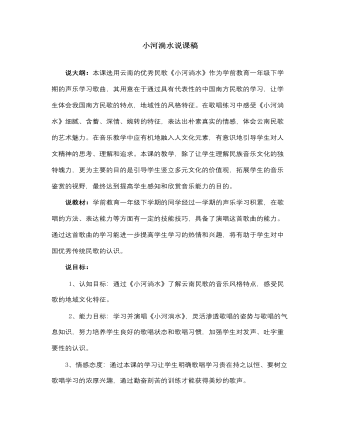
人音版小学音乐六年级上册小河淌水说课稿
长期以来,我们的高中音乐课堂在注重学生感官体验的同时,却忽略了对学生的音乐表现能力的培养,我们一直认为活泼、律动的音乐课是小学和初中的音乐课特点,而高中音乐课堂应该是知性的,理性的。但在本课的教学过程中,学生所表现出的热情与活跃,积极与投入改变了我的看法。但还是有不足之处:1、采用集体大课教学,无法对学生个体的歌唱问题进行纠正,因此学生个体的歌唱能力提高缓慢。仍然达不到理想的要求,常常有齐唱如花,个别唱如草的感叹。2、声乐课堂作业的完成情况不佳,许多同学下课后根本没练习,连歌词都记不了,在学习的监管上要加强。3、在课堂教学中没有让学生的个唱能力得到展现,不利于学生个性特征的发挥,也不利于学生学习兴趣的进一步激发。今后在课堂上应让更多的学生起来范唱,正面的、反面的都可以,这样能帮助大家树立声乐学习的正确认识,对声音的正确概念有比较明确的判断。
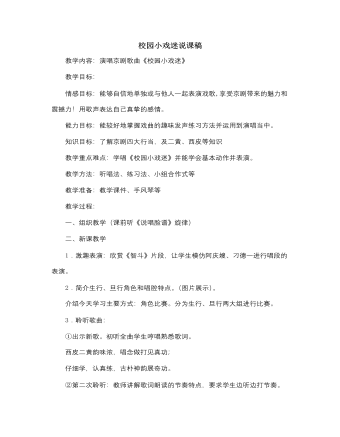
人音版小学音乐六年级上册校园小戏迷说课稿
教学反思:京剧是我们的“国粹”,既称“国粹”,自是国之经典,京剧博大精深,只要能够静下心来去听,静下心来去看,能够深入进去,一定能找到你喜欢的,有意思的内容,我们在课上了解京剧行当时很多学生都很感兴趣,学生对不同行当人物的装扮、亮相,一招一式都看的特别投入,有的学生还跟着表演起来,看的出学生觉得很有意思,至少能吸引他们的注意,然而在歌曲学唱中效果就一般了,由于歌曲京韵味很浓,一字多音特别多,因此,很多学生唱不准,京韵味就更难做出来了,课堂教学中,我只能以让学生多听、多模仿为主,然而很多学生不认真,自然是觉得没兴趣,因此,学唱效果一般。或许京剧流行的年代离学生们太远,平时接触的又少,因此,提倡的“京剧进课堂”的想法并不是我们一朝一夕能达到的,京剧进课堂,能否也唱进孩子们的心里?需要我们所有人重视并参与,让我们共同为京剧的美好明天而努力吧。
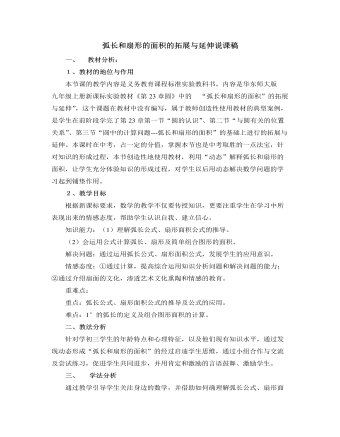
北师大版初中数学九年级下册弧长和扇形的面积的拓展与延伸说课稿
五、教学反思:时钟的秒针、分针、时针扫的图形, 汽车挡风玻璃的刮水器;刷工人刷过的面积近似看为扇形。圆中的计算问题---弧长和扇形的面积,虽然新课标、新教材要求学习,但本节教师结合学生的实际要求,将其作为内容进行拓展与延伸,具有一定的实际意义。用生活中动态几何解释扇形,体验解决问题策略的多样性,发展实践能力与创新精神。本节课,教师通过“扇子”的问题情景引入新课,它蕴含了大量的情感信息,有效激发学生的求知欲望,充分调动学生的学习积极性,注重学生的参与,让出时间与空间由学生动手实践,鼓励学生自主探索、合作交流、展示成果,提高了学生发现问题、提出问题、解决问题的能力。用“扇子变化”,帮助学生探索自然界中事物的动静结合问题,利用“扇子的文化”的新奇感激起学生的学习热情,陶冶了学生的学习情操,从而使学生更深切地理解问题,使原本单调枯燥的数学变得生动、形象,激发学生的情感,使课堂充满生机。
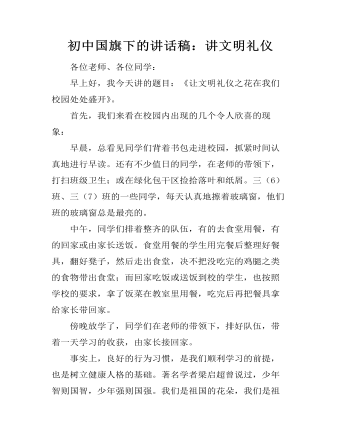
初中国旗下的讲话稿:讲文明礼仪
各位老师、各位同学:早上好,我今天讲的题目:《让文明礼仪之花在我们校园处处盛开》。首先,我们来看在校园内出现的几个令人欣喜的现象:早晨,总看见同学们背着书包走进校园,抓紧时间认真地进行早读。还有不少值日的同学,在老师的带领下,打扫班级卫生;或在绿化包干区捡拾落叶和纸屑。三(6)班、三(7)班的一些同学,每天认真地擦着玻璃窗,他们班的玻璃窗总是最亮的。中午,同学们排着整齐的队伍,有的去食堂用餐,有的回家或由家长送饭。食堂用餐的学生用完餐后整理好餐具,翻好凳子,然后走出食堂,决不把没吃完的鸡腿之类的食物带出食堂;而回家吃饭或送饭到校的学生,也按照学校的要求,拿了饭菜在教室里用餐,吃完后再把餐具拿给家长带回家。傍晚放学了,同学们在老师的带领下,排好队伍,带着一天学习的收获,由家长接回家。事实上,良好的行为习惯,是我们顺利学习的前提,也是树立健康人格的基础。著名学者梁启超曾说过,少年智则国智,少年强则国强。我们是祖国的花朵,我们是祖国的未来。如果我们养成了文明的行为习惯,学习环境就一定是良好的、有序的。
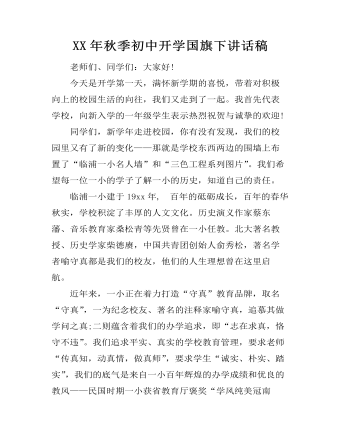
XX年秋季初中开学国旗下讲话稿
老师们、同学们:大家好!今天是开学第一天,满怀新学期的喜悦,带着对积极向上的校园生活的向往,我们又走到了一起。我首先代表学校,向新入学的一年级学生表示热烈祝贺与诚挚的欢迎!同学们,新学年走进校园,你有没有发现,我们的校园里又有了新的变化——那就是学校东西两边的围墙上布置了“临浦一小名人墙”和“三色工程系列图片”。我们希望每一位一小的学子了解一小的历史,知道自己的责任。临浦一小建于19xx年, 百年的砥砺成长,百年的春华秋实,学校积淀了丰厚的人文文化。历史演义作家蔡东藩、音乐教育家桑松青等先贤曾在一小任教。北大著名教授、历史学家柴德赓,中国共青团创始人俞秀松,著名学者喻守真都是我们的校友,他们的人生理想曾在这里启航。近年来,一小正在着力打造“守真”教育品牌,取名“守真”,一为纪念校友、著名的注释家喻守真,追慕其做学问之真;二则蕴含着我们的办学追求,即“志在求真,恪守不违”。我们追求平实、真实的学校教育管理,要求老师“传真知,动真情,做真师”,要求学生“诚实、朴实、踏实”,我们的底气是来自一小百年辉煌的办学成绩和优良的教风——民国时期一小获省教育厅褒奖“学风纯美冠南乡”

新人教版高中英语必修2Unit 2 Wildlife Protection-Listening &Speaking&Talking教案
Listening and Speaking introduces the topic of “how to save endangered wildlife and help wildlife in their neighborhood.” Due to the continuous deterioration of the living environment, a large number of wild animals are always facing the threat of endangered or extinction. Listening and speaking period enables students to understand the fact and reason why wild species are disappearing from the earth at an amazing speed, and realize that human beings ought to enhance the awareness of protecting wild species as soon as possible.Listening and Talking introduces the theme of " how to help wildlife in Ss’ neighborhood.". Now there are many volunteers who spontaneously protect wild animals, carry out various activities according to local conditions, and contribute their own strength to local animal protection with practical actions. Middle school students are also enthusiastic participants. They organize activities in their spare time, and take this opportunity to make friends, broaden their horizons, cultivate team spirit and communication skills. This section describes a bird watching activity organized by several middle school students of Bird watching Club. It aims to stimulate students' interest, improve their understanding of bird watching activities, and use the language structure of “being used for; in order to, so as to, to, so that, in order that ” to express the purpose for communication and discussion.1. Guide students to understand the content of listening texts in terms of using visuals to predict content.2. Cultivate students' ability to guess the meaning of words in listening; discuss with their peers how to save endangered wildlife and help wildlife in their neighborhood.3. Instruct students to use functional sentences of the dialogue such as “I am concerned about…” “what do you know about the endangered animals in…" and so on to talk about one of the endangered animals.

新人教版高中英语必修2Unit 2 Wildlife Protection-Reading for Writing教案二
This lesson aims at making a poster about protecting wildlife after reading some posters. During reading students are guided to understand the content and try to summarize the posters with one sentence. Then students are guided to try to make a poster about protecting wildlife.1. Read the two posters and try to understand the summary sentences.2. Look at the two posters and try to understand what emotions they express.3. Try to summarize the features of posters4. Try to make a poster about wildlife.1. Look at the two posters and try to understand what emotions they express.2. Try to summarize the features of posters3. Try to make a poster about wildlife.Step 1 Lead inLook at the the posters on the textbook and ask:Which emotions do the posters communicate ?Step 2 Read the poster and answer the questions.1. What do you think of the animals in the poster on the left ?I think it is frightening and ugly.2. Why do we should protect the ugly animals ?All species--the good, the bad, and the ugly-- should be treated equally.The world needs all kinds--without variety, our planet cannot survive.3. Why are billions of trees being cut down every year ?To make paper for humans.4. What result will be lead to after the trees are cut down ?A lost of animal homes are being destroyed./The habitat of wildlife is being destroyed.Step 3 Find the feature of posters1. What does each poster use to stir up emotions ?On the left, it makes us a little frightened and it looks a little ugly, but it can activate our curiosity--What is it? And What is wrong with it?On the right, it makes us feel a little sad and want to protect them.

新人教版高中英语必修2Unit 2 Wildlife Protection-Discovering Useful Structure教案二
2.表示现阶段正在进行的被动动作(该动作在说话的瞬间未必正在进行)。Many interesting experiments are being carried out these days.(说话时,并不一定正在进行)3.表示一种经常性的被动行为,常和always,constantly 等表示频度的副词连用,这种用法常常带有赞扬或厌恶的感情色彩。He is always being praised by the leader.4.表示按计划或安排主语将要承受谓语动词所表示的动作(仅限于少数及物动词)。A party is being held tonight.Step 4 Special cases1.像take care of, look after, talk about, think of等动词与介词构成的短语用于现在进行时的被动语态时, 其中的介词不可省略。The ways to stop illegally hunting are being talked about. 2.可与部分情态动词连用,表示对正在发生的事情的推测。She may be being punished by her mother.3.有时可表示按计划或安排将要进行的一个被动动作。A celebration is being held this weekend for his success.4.某些表示“状态、心理活动、存在”等的动词,如have,want,need,love,一般不用现在进行时的被动语态,而常用一般现在时的被动语态。With the population increasing,more land is needed.5.“be+under/in+n.”可表示现在进行时的被动意义。My computer is under repair.=My computer is being repaired.

新人教版高中英语必修2Unit 2 Wildlife Protection-Discovering Useful Structure教案一
The activity topic of this section is "report an ongoing event", and the structure is the passive voice of present continuous tense. Rare wild animals are suffering from large-scale poaching, and species are on the brink of danger. Rescue operations are underway. "Being" and "suffering" are the meanings of the present progressive passive voice.The usage of present progressive passive voice is of great importance in writing a good discourse and appreciating some difficult language items, so it is vital to master it and use it flexibly in a context.1. Motivate Ss to deepen the understanding of the usage of present progressive passive voice in a fixed context.2. Enable Ss to master the usage of present progressive passive voice and use it flexibly in a context.3. Lead Ss to construct sentences or appreciate sentences used master it and use it flexibly in a context.1. Help students to appreciate the function of the usage of present progressive passive voice in a sentence2. Instruct students to write essays using the proper usage of present progressive passive voice.Look at the picture and tell me what are workers doing? What is the house being done?

新人教版高中英语必修2Unit 2 Wildlife Protection-Reading and Thinking教案一
The listening and speaking part aims at how to protect and help endangered animals by listening, speaking and talking about the facts and reasons. This lesson analyzes the decreasing clause of Tibetan antelope population and the measures of protecting Tibetan antelopes. So students can be guided to learn to analyse the title and use different reading skills or strategies, like scanning, skimming and careful reading.1. Read quickly to get the main ideas and the purpose of going to Tibetan; read carefully to understand what the author see and think.2. Understand the sentences of the present continuous passive voice such as “Much is being done to protect wildlife.” and the inverted sentence “Only when we learn to exist in harmony with nature can we stop being a threat to wildlife and to our planet.”3. Enhance the awareness of protecting wildlife.4. Cultivate the reading methods according to different materials.1. Read quickly to get the main ideas and the purpose of going to Tibetan; read carefully to understand what the author see and think.2. Understand the sentences of the present continuous passive voice such as “Much is being done to protect wildlife.” and the inverted sentence “Only when we learn to exist in harmony with nature can we stop being a threat to wildlife and to our planet.”3. Cultivate the reading methods according to different materials.Step 1 Leading-inWatch a video about elephants and whales and then ask:Why are they endangered ? They are killed/hunted

新人教版高中英语必修2Unit 2 Wildlife Protection-Listening and Speaking教案
This lesson is about wildlife protection. The listening and speaking is about “How to protect endangered wildlife ?” Faced with the facts and numbers of wildlife loss, people begin to detect the reasons, then people such as the celebrities (Prince William and Yao Ming) are calling on to protect them. So students are guided to enhance the awareness of protecting wildlife and try to take part in some volunteer activities of protecting wildlife.1. Predict the content by using visuals. 2. Learn to use the sentences such as “I’m concerned about.... But now they are in danger. I want to know the reasons/why./ What can we do to protect them ?3. Learn from the stars like Prince William and Yao Ming and enhance the awareness of protecting wildlife.4. Guide students to try to put forward the solutions to the problems of wildlife protection and then discuss them with partners and present the results of discussion.5. Master the pronunciation of stressed syllables.1. Learn from the stars like Prince William and Yao Ming and enhance the awareness of protecting wildlife.2. Guide students to try to put forward the solutions to the problems of wildlife protection and then discuss them with partners and present the results of discussion.3. Learn to use the sentences such as “I’m concerned about.... But now they are in danger. I want to know the reasons/why./ What can we do to protect them ?4. Master the pronunciation of stressed syllables.Part A Listening and Speaking--- How to save endangered wildlifeStep 1 Lead in1. Point at the pictures on P14 and ask Q1: What message do these posters share?

新人教版高中英语必修2Unit 2 Wildlife Protection-Reading and Thinking教案二
The theme of this unit is human and nature, focusing on the theme of wildlife protection. Nature is a complex ecosystem, in which there are delicate balance between animals and plants. Because of the role of the food chain, the extinction of one species will produce influence, causing a series of chain reaction. Large scale extinction of species will have a serious and even irreversible impact on the ecosystem, resulting in immeasurable losses. Therefore, it is of great significance to protect wild species. To protect wild species is to protect human beings themselves. The motto of this unit is "when the buying stops, the killing can too,” which is a public service advertising slogan to protect wildlife. It tells people that every rhinoceros horn, every fur, every bowl of shark fin soup, every Ivory product, and every tiger bone product, etc. consumed by human beings, are innocent wild animals slaughtered behind them. The mission of wild aid is to ban illegal trade in endangered wildlife and mitigate climate change. It aims to educate the public to reduce the consumption demand for endangered wildlife products through public publicity and improve the awareness of environmental protection.1. Improve the awareness of wildlife protection by acquiring the knowledge of wildlife protection.2. Focus on environmental protection and protection of all lives.3. Analysis of the living environment of wild animals with appropriate thinking mode.4. Skillfully use the vocabulary and grammar knowledge of this unit to cultivate self-study ability according to the unit content5. Develop cooperative learning ability through discussion and other ways1. Enable the Ss to talk about the current situation of wild animals.2. Guide the Ss to summarize the main idea of each paragraph as well as the main idea of the text.